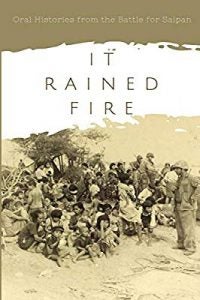Research Spotlight

It Rained Fire: Oral Histories from the Battle for Saipan
Stephanie Soder and Jennifer McKinnon
The book “attempts to add to and expand the collective memory of suffering and resilience of indigenous Pacific Island survivors and their family members through recording and sharing their voices.”
What was the inspiration for the book?
McKinnon: The book was inspired by Stephanie and my desire to continue to make publicly accessible products for the community of Saipan because of the explicit Community Archaeology approach we use. Community Archaeology is a decolonizing approach to archaeology that incorporates the community in all aspects of archaeology from research design to interpretation.
Soder: Expanding on what Jen said, we really wanted the book to emphasize the oral histories collected from community members. They pass their history along to the next generation through storytelling. So in order for us to really embrace the Community Archaeology approach, it just made sense that the book should be written using their own words. It was really important to embrace their traditions while still being able to disseminate the information to a broader audience.
What did you find to be the most challenging aspect of the project?
Soder: For me, the most challenging part was to work out the logistics of finding community members to contribute. Not living on or having easy access to the island meant that we had to do a lot of prep work before setting foot on Saipan. We put out newspaper ads and social media posts before starting fieldwork, and then once on island, did a radio interview to try to encourage the community to speak with us. But only one person came forward between all of those methods. Thankfully, we had Fred Camacho as our Local Heritage Consultant, and just by word-of-mouth, he was able to get the other 30 participants to speak with us. The really great thing is that almost all of the community members that spoke with us had never shared their stories before, so these are all new perspectives. This project would not have been as successful without Fred’s help.
What did you find was the most rewarding aspect of the project?
McKinnon: I know Steph will have her own answer, but for me it is to see another piece of indigenous Pacific Islander history revealed. For too long their voices have been left out of the history we write. So to see it come to light and in their own words is most rewarding to me.
Soder: I’m absolutely honored that the community members entrusted us with their stories. This project wasn’t just about documenting history, it was a way for the indigenous to take control of their own narratives. For me, knowing that this project had real-world, positive impacts was the most rewarding. I think for some of the participants, it was really cathartic to speak with someone who was outside of the community about their experiences. Allowing for anonymity helped some of them feel comfortable enough to discuss experiences or opinions that may not have been accepted by others in the community. In one instance, one of the interview participants expressed interest in connecting with the U.S. soldier who had helped her family during the battle. Taking the information that she had already collected and doing a little more research through the National Archives and genealogy websites, we were actually able to connect her with his family. Being able to help people in the community was so important.
Where can people access the book?
McKinnon: People can purchase a hardcopy book via Lulu.com (the cost is only for production) and free digital copies can be accessed via Academica.edu, Researchgate.net, and eventually on the funding organization’s website.